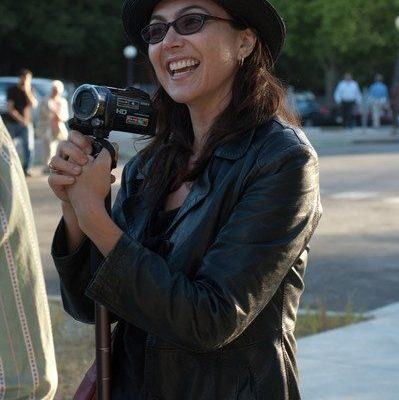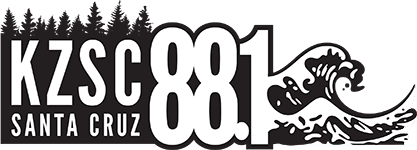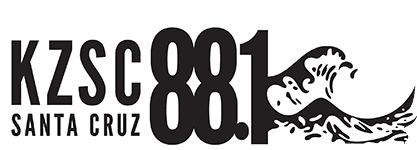
Many of you are probably familiar with KZSC’s talk program Artists on Art. But how much do you know about Nada, aka DJ Hope? I sat down to learn a little more about the voice behind the mic, and this month’s Programmer of the Month.
Shay: Hi Nada, thank you for joining me this afternoon.
Nada: You’re very welcome, Shay.
Shay: I wanted to know a little bit about Artists on Art and yourself.
Nada: Well thank you! I’m very honored to be asked. I started Artists on Art in January of 2009. I was studying here at UCSC in the Digital Arts and New Media program, it’s the MFA program here on campus, and I’d been living in Santa Cruz, at that point, to get a show here at KZSC, and it’s a little difficult, or challenging, because you have to have the radio class and you have to pass the radio class to be able to be a DJ and to have an interview talk show like I have. So not being a student, it was a little difficult. And so while I was studying I thought, hey, I’m going to, you know, use this opportunity (laughs) to take the class. So I took the class in fall of 2008.
S: Where are you from?
N: Originally from the former Yugoslavia. I’m originally from Serbia and then my parents immigrated when I was little to Chicago. I grew up outside of Chicago on the east side of Indiana and then I went to Purdue for my undergraduate degree. I came out to California after I graduated in 1989. I moved to San Francisco and then I moved to Oakland, where I was inspired to get a radio gig at KALX. Then we moved to Santa Cruz, so I’d been trying to get something here and that was it! That was my chance.
S: Awesome! What did you study as an undergraduate and graduate?
N: As an undergraduate I was a triple major, I was a crazy person.
S: What?!
N: I did construction management, philosophy and fine arts. I didn’t get my fine arts degree, I got my BS and then I got my BA but I didn’t get my BFA . Then when I turned 40 I had a mid life crisis kinda thing (laughs) and so I actually went back to school for my masters in fine arts and I studied Digital Arts and New Media–meaning, new media as an art form and digital being anything that’s computer…intervened.
S: What kind of art do you do yourself outside of KZSC and interviewing other artists?
N: I have a project that I call the Santa Cruz Sad Song Project and what that is is I make a little space, that is I have a video booth that’s kind of a stage and I invite people to sing or perform their sadness.
S: That is wonderful.
N: And the reason being is that I truly believe in the power of catharsis through great art and so the idea is if you are singing or dancing your sadness, those that are watching it, not only the participant but also the audience, the spectators, can feel the pain and let it go. And hopefully in letting it go, you are lessened for a brief moment in time of your sadness and it’s actually an idea that goes back to Hindustani where they believe that you’re born with a sadness. The reason that you are sad is because you are through the encapsulation of the body, you are separated from God, and God is love. And so we, after birth, are forever moving through life and accumulating this grief from our separation from love. And that through, for the Sufis, dancing the Dervish, the Dervish dancers through song and dance and chanting you can transcend for a moment and be closer to love or god and be lighter
S: That’s really great.
N: And so I’ve done six performances, two at the Museum of Art History here in Santa Cruz and a whole bunch during the monthly art tour, First Friday, and I’d say I’ve had about 60 participants, a lot of them are online and it’s funny when you have the performance, you’re listening, and everybody’s like, nobody breathes, it’s this very like *gasps* and you’re in this sadness and then afterwards everybody giggles and it’s like, “Whew, glad that’s over,” you know? (Laughs) I don’t know it’s funny.
S: Can I come?
N: Oh please do! And like I said, you don’t have to sing, you can do anything you want to express.
S: What a great platform. Where did you come up with that idea?
N: It came from my studies here at UCSC. I started really thinking about performance art and using performance art as an activist. That is, using performance as a way to educate people, as a way to engage, break down the wall between the participant but actually have them an active part, so maybe in the past you would say more spectator; I truly believe in the power of participation.
S: Awesome. So tell me about what kinds of artists you interview on your show, Artists on Art.
N: So I just had the incredible pleasure of interviewing Guillermo Gómez-Peña, who is, in some ways, one of the greatest Chicano performance artists in the world. He’s been creating Chicano art and working at the intersection between borders–He is a Mexican American, and has been working with that issue of border since the late ‘70s, since he started performing. He was a Resident in Art at UCSC at the beginning of November, and he did a couple of performances and a performance artist workshop and so he’s been one of the biggest thrills that I’ve done lately. I’ve also interviewed the performance artist Beth and Annie, Beth Stephens and Annie Sprinkle. Beth is a UCSC professor in the art department and Annie Sprinkle is her wife and they do eco-art performances, they have a new movement called ecosexuality where they want to bring sexiness to the environmental movement.
S: I love it! (Laughs)
N: (Laughs) I interviewed Kim Gordon of Sonic Youth. I’ve interviewed a couple times the godmother of punk, Nina Hagen. Another huge performance artist that I had the pleasure of interviewing was Karen Finley.
S: It’s such a broad show, I’ve heard a few times (in between classes and what not), and every week it’s just such varying artists because it’s anything from performance art to fine art and I think that’s really amazing.
N: And authors. I consider writers artists. I actually, as a conceptual artist, believe that you can use anything as a medium. Life can be your art medium. And so that’s one of the biggest reasons why I’m doing artists on art is because I want people to have as much art in their life as possible. And if they could think that they could use that mindfulness or that thoughtfulness to everything that they do, which is kind of what you have to do when you go into that art space, right? And so, if somebody’s listening to my show and says, “Wow, I can do that. I can make that art. I can think that way,” ‘cause as a conceptual artist, you can just have a thought, you don’t have to have anything, it can be an idea.
S: Yeah. That’s so cool!
N: (Laughs)
S: Okay, now I’m going to go through like a lightning round of questions, just random questions.
N: Okay.
S: What is your middle name? It’s a question that I like asking everyone.
N: I don’t have a middle name.
S: See! I hear that response way too much and that’s why it’s interesting to me.
N: It’s not a Serbian custom.
S: Mhmm. I totally understand that. If you could have a conversation with any deceased person, such as an artist or historical figure, who would it be?
N: God that’s so hard. Oscar Wilde. I love Oscar Wilde. Oh my god! Plato. I mean it’s like… who would be, um… Simone de Beauvoir.
S: …Who is that?
N: Simone de Beauvoir is one of the greatest feminists ever. She wrote The Second Sex. She was partners in crime with the great existentialist, oh god what’s his name…he wrote…
S: Sartre?
N: …Being and Nothingness. Yeah! Jean-Paul Sartre. In fact, Jean-Paul was always second-in-class to Simone.
S: Ooooh. I’ve studied Sartre in school here at UCSC but I haven’t heard of Simone.
N: Simone-slap-me-up-side-the-head and said, “Girl! Wake up! Be the feminist that you are!”
S: I definitely need to read that. It will be my winter break read. All right, name a few of your favorite albums during high school.
N: During high school… Stop Making Sense by the Talking Heads. I was a huge, huge, oh my gosh there’s so many, I was a huge Doors fan, I’m trying to remember that first album…um, huge Beatles fan, all the Beatles, from beginning to end, Ob-La-Di, Ob-La-Da was one of our high school anthems. Let’s see, The Animals. I started getting into punk my senior year, I’m trying to remember, you know the talking heads are kinda like that gateway one. Yeah. I think I really started listening to like goth music in college, like Siouxsie and the Banshees and the Cure and Bauhaus, all of that was kinda after high school. I graduated in ’84 so punk was just coming to the Midwest. But then Chicago had this fabulous art scene where we had Ministry and Big Black and Wax Trax!.
S: Tell me a story about a time when you had trouble with a car.
N: When I had trouble with a car… I drove to Chicago and I was 16 years old and I didn’t know how to park parallel. And so I was like, trying to parallel park right off of Michigan avenue, like right around Oak Street. Somebody was watching me in their apartment and was so disgusted by what I was doing that he came down stairs and he actually made me get out of the car and sit next to him while he explained to me how he was parallel parking, unparallel parked it, made me practice and get it so where I had to parallel park it. And I use his parallel parking techniques to this day.
S: He was a stranger?
N: He was a total stranger! And I even taught my daughter how to parallel parking using the same technique. I was both humiliated and thrilled.
S: I’m sure. I would be so freaked out. I was raised with complete stranger danger; I would have just driven off.
N: Right. Maybe I should have, but I really wanted to park that car.
S: How many languages do you speak?
N: Well I’m kinda lucky, because Serbian is Bosnian and Croatian, so I get the 3-for-1 with the Serbo-Croatian. And Montenegrin, we could go four I guess, which is not really fair. So I speak Serbo-Croatian, Bosnian-Montenegrin and I studied French in high school and college and had a moment where I could speak it when I was in Paris.
S: It’s a beautiful language.
N: I love love love French. I’ve been trying to teach myself Spanish for years, I mean, you know.
S: California.
N: Yeah. You gotta learn Spanish.
S: Plot twist! Someone asks you to be on Artists on Art. What would they interview you about?
N: What would they interview me about…well, I’m making a movie right now, so I guess I’d probably want that. I’m making my second full feature film, it’s called The Force Majeure and it’s with two, actually they’re professors, emeritus professors, they taught at UCSD for 30 years I believe, or 20 years, and they’re teaching here, and they’re Helen and Newton Harrison. They’re eco-artists, they’re eco-environmental artists-activists and they’ve come up with an idea concerning global warming and how to, in some ways, meet the force using entropy math and, actually, creating a new science of entropy analysis and having the idea that when you take energy out of a system you introduce entropy, which is what we’ve done and that’s why we have global warming. We’ve extracted our resources and continued to extract our resources, and consume at such a rate that we’ve brought on a high entropy situation which means chaos looms and the storms are going to be bigger and the droughts are going to be longer and the floods and subsequent rising of the oceans ‘cause of the glacial melt need to be treated the same way nature treats nature and that is we need to not only stop what we are doing, consuming, but also return if not as much but more of what we’ve taken from nature.
S: Wow.
N: We gotta recharge the planet.
S: So you’re making a documentary about them?
N: Yeah. About this very thing.
S: Okay! That’s great.
N: Recharge the planet!
S: There it is! I like it. Are you going to screen it anywhere? When do you expect it to be finished?
N: Oh of course, I’ll do whatever I can. Well, next year. 2015. Be here next year.
S: I will be. I can’t wait to see it. I recently read a headline quoting Sean Lock and it said, “Nobody over sixty five should be allowed to vote because it’s not their future.” What do you think of this?
N: Wow. Well, there are a couple things about that. So, 65 is actually kinda young, in a way. Sixty is like the new 40 (laughs). So I think 65 might be a little too young, people are still very active and it is still their future in some ways. It’s also eliminating the idea that people actually care what their grand-kids are going to have, and so in some ways I agree, but in some ways I also disagree, and that there’s a wisdom that’s collected and emerges after living a lifetime and why maybe a lot of the indigenous peoples had elders that kind of advised how the village was going to be. And so when you take out that much knowledge base, you’re bound to lose a lot with it. It’s kind of throwing the baby out with the bathwater. There should be…I think voting is one of the greatest privileges that we have, starting from the ancient Greeks, I was just reading Plato’s take on how really you should be educated and have had some philosophical training before you can vote. So if I was going to put some parameters on who can vote, it wouldn’t be age or cultural or sex or anything like that, it would be actually have you been trained in the philosophical manner and do you know yourself, and after you have self-awareness and hopefully though that experience you also have some feeling and responsibility to yourself, the world, generations, your society, your city, whatever, however you want to break it down, then you can vote.
S: I like it. That’s a great take on that.
N: The other one’s a little ageist.
S: Yeah, it’s really interesting because in some ways, if you’re not working, it’s not your future, but at the same time, like you said, 60 is the new 40. I look at my grandmother whose in her 60s and she feels like the parent whereas my parents feel like they’re very young still.
N: Yeah, right. I mean, I’m 48, turning 49 and I’m just starting to feel like an adult. You know, I’m looking at 50. You’re hoping you live to your 90s; it’s like, 40 more years!
S: It’s a big chunk off of your life! Definitely. Last two questions. What is your favorite trend?
N: I used to shave the sides of my head when I was in college and I’m really glad that that’s back now. I love it! You know, it started with Rihanna, I think she started it a couple years ago and now Prince was on Saturday Night Live and his women all had the undercut shave.
S: What is your least favorite trend?
N: The bones in the nose. That was a trend in the ‘90s in San Francisco.
S: What?!
N: Yeah it was that whole primitive art thing. There was this trend for a moment where everyone was putting bones so they had like these big bones or big rings like you would do the bull…
S: I feel like that’s very culturally appropriating.
N: Yeah. It was crazy. I tried to act like I didn’t know. I mean there were, like, tusks, people were wearing…. (laughs)
S: I’m glad I was born in the ‘90s and didn’t actually witness it. Or wasn’t conscious to witness it.
N: Right right right!
S: Thank you so much, we’re so happy to have you as the PRC’s programmer of the month!
N: I’m thrilled!
You can tune into Artists on Art every Wednesday from 12-1pm, and learn more about the show at Nada’s website. Happy New Year from KZSC to you!

